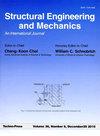考虑FFDI的混凝土重力坝震害指数综合
IF 2.2
4区 工程技术
Q2 ENGINEERING, CIVIL
引用次数: 0
摘要
通过损伤指标的确定来反映结构的性能水平,可以构成基于参数分析的地震风险概化方法。本研究将这一概念应用到混凝土重力坝这一土木工程结构中。结构的不同情况表现出各自的响应,这构成了不同的考虑。因此,这种方法允许对混凝土和土壤进行参数化研究,以评估广义情况下的地震性质。为了确保目标算法适用于大多数混凝土重力坝,考虑了一个非常简单的程序。为了开发一种相关的算法(采用响应面法);采用半分式中心复合设计的随机方法,采用随机抽样的方法,研究了地震动与结构性能之间的关系。在流体-基础-大坝相互作用(FFDI)情况下,将基础引入无限元边界,使其更加可靠。为了评价FFDI模型的地震泛化性,选取太平洋地震工程研究中心的地震资料,在不同地震记录的影响下进行了增量动力分析。本文建立了基于位移的损伤指数易损性曲线,以反映大坝地震模式的变化。本文提出的各参数敏感性分析的响应是混凝土重力坝最有效的控制因素。最后,为了确定所提方法的准确性,本研究采用了可靠的验证方法。本文章由计算机程序翻译,如有差异,请以英文原文为准。
Damage index based seismic risk generalization for concrete gravity dams considering FFDI
The determination of the damage index to reveal the performance level of a structure can constitute the seismic risk generalization approach based on the parametric analysis. This study implemented this concept to one kind of civil engineering structure that is the concrete gravity dam. Different cases of the structure exhibit their individual responses, which constitute different considerations. Therefore, this approach allows the parametric study of concrete as well as soil for evaluating the seismic nature in the generalized case. To ensure that the target algorithm applicable to most of the concrete gravity dams, a very simple procedure has been considered. In order to develop a correlated algorithm (by response surface methodology; RSM) between the ground motion and the structural property, randomized sampling was adopted through a stochastic method called half-fractional central composite design. The responses in the case of fluid-foundation-dam interaction (FFDI) make it more reliable by introducing the foundation as being bounded by infinite elements. To evaluate the seismic generalization of FFDI models, incremental dynamic analysis (IDA) was carried out under the impacts of various earthquake records, which have been selected from the Pacific Earthquake Engineering Research Center data. Here, the displacement-based damage indexed fragility curves have been generated to show the variation in the seismic pattern of the dam. The responses to the sensitivity analysis of the various parameters presented here are the most effective controlling factors for the concrete gravity dam. Finally, to establish the accuracy of the proposed approach, reliable verification was adopted in this study.
求助全文
通过发布文献求助,成功后即可免费获取论文全文。
去求助
来源期刊

Structural Engineering and Mechanics
工程技术-工程:机械
CiteScore
3.80
自引率
18.20%
发文量
0
审稿时长
11 months
期刊介绍:
The STRUCTURAL ENGINEERING AND MECHANICS, An International Journal, aims at: providing a major publication channel for structural engineering, wider distribution at more affordable subscription rates; faster reviewing and publication for manuscripts submitted; and a broad scope for wider participation.
The main subject of the Journal is structural engineering concerned with aspects of mechanics. Areas covered by the Journal include:
- Structural Mechanics
- Design of Civil, Building and Mechanical Structures
- Structural Optimization and Controls
- Structural Safety and Reliability
- New Structural Materials and Applications
- Effects of Wind, Earthquake and Wave Loadings on Structures
- Fluid-Structure and Soil-Structure Interactions
- AI Application and Expert Systems in Structural Engineering. Submission of papers from practicing engineers is particularly encouraged.
 求助内容:
求助内容: 应助结果提醒方式:
应助结果提醒方式:


